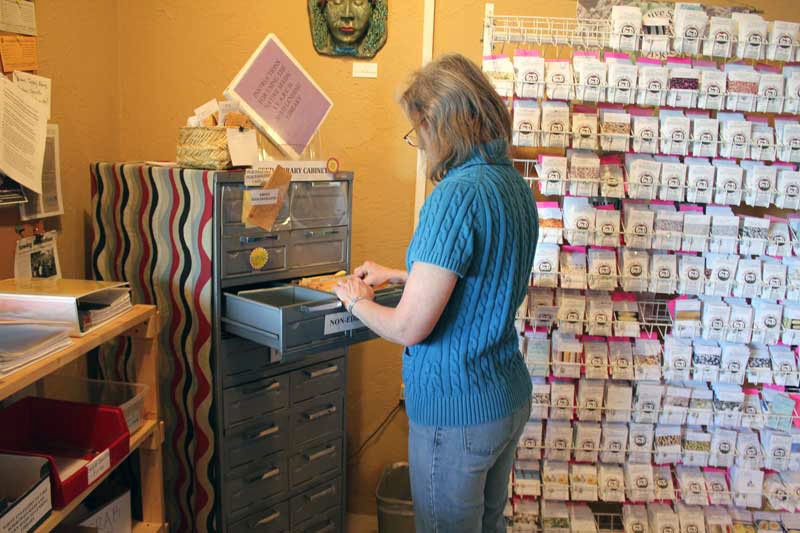
Native Seeds/SEARCH has long been a proponent of local agriculture for a sustainable food system. But rekindling a connection to place and the natural world goes beyond our garden plots and dinner tables. Many people are exploring ways to make other important aspects of our everyday lives more healthful and sustainable—such as the very homes we live in.
There is a revival of interest in natural building methods taking place around the world that is closely aligned with the growing movement toward heirloom food and seeds. Utilizing locally sourced materials such as earthen clay and straw, natural builders are working with ancient construction techniques to create handcrafted dwellings that are more beautiful and environmentally sound than our modern homes.
Bill and Athena Steen of the Canelo Project are world-renowned natural builders hailing from the bucolic backcountry of Elgin, Arizona, not far from our own Conservation Farm in nearby Patagonia. When NS/S decided we would like to begin building an educational campus on our farm, we knew we wanted to experiment with natural building techniques. The Steens were an obvious choice to help us bring our vision to life. Over two weekends in September and October, Bill and Athena will be leading workshops on the NS/S farm to construct a beautiful straw bale cottage by hand, from start to finish.
 In anticipation of this exciting project, we recently chatted with Bill about his philosophy on sustainability, local agriculture, and of course, straw bales.
In anticipation of this exciting project, we recently chatted with Bill about his philosophy on sustainability, local agriculture, and of course, straw bales.
NS/S: The Canelo Project is known for developing a unique method of natural building with straw bales in combination with clay plasters. Explain a little about this method, and why straw and clay work so well together for building.
Bill Steen: There's an old adage in Mexico that an adobe without straw is like a person without a soul. In some ways, that simple description is perfect. In another way, you could say that the straw makes the clay behave. It becomes more moldable, keeps it from cracking when it dries and makes it more weather resistant. And even though adobe or clay based materials will wear some on the exterior of a building, they provide a perfect waterproof barrier for the straw in much the same way that clay can be used to seal a pond. In contrast, cement and lime readily give up water to the straw.
At Native Seeds/SEARCH, our focus is on gardening, seeds, and regionally adapted agriculture. How would you say that straw bale building is related to the work we do?
Originally my interest was more with gardening and agriculture, but having grown up in the Southwest, I always had a strong connection to adobe. When I learned about the possibility of building with straw bales, a waste product of cereal grain production, I thought of it as a perfect way to add the one thing that adobe walls lacked: insulation. When I first met Athena we shared that same vision—of dwellings with straw bale walls coated with adobe-based plasters, clay paints, clay floors and furniture. And so our work began.
Natural building has been around for thousands of years. Why do you think this building style is seeing a resurgence today?
Like the rising interest in local food, I think it’s part of that same effort to improve every aspect of our lives. You can't be concerned about organic and local food production for long before realizing that the house or space where you work is every bit as important. Along with pesticides, herbicides and chemical fertilizers, most modern building materials are either toxic or their production has negative consequences for the environment as a whole.
We hear a lot about “green building” techniques these days, but your method seems to be sustainable on a more fundamental level. What would you say are the biggest benefits to straw bale building for sustainability?
Much of "green building” is concerned with marketing products that are often over-hyped and expensive, although there are many great new products becoming available. And yet, straw bales require almost no processing, contain very little embodied energy compared to other manufactured products, and are just so simple at that fundamental level. One disadvantage you might find is that they require more labor to work with compared to modern materials, which are designed to be fast and easy. But instead of a house made from cheap drywall and latex paint, a natural straw bale and clay dwelling becomes something special that is alive and vibrant.
As simple as all this sounds, building a house seems like it takes a lot of skill. Will participants realistically be able to do this on their own after attending these workshops?
Much depends on the skill level of the participant. If they are already a skilled builder, then obviously it might be easier for them. And yet, a mind that is fresh and free from pre-conceptions can be advantageous. In reality, most building is done in partnership with others who provide the skills one is lacking. So I would say that people will learn the main essentials while gaining an understanding as to what type of complementary help they need.
Bill and Athena Steen will be teaching a Straw Bale Cottage Workshop series on the NS/S Farm on September 13-15 and October 19-21.Enhance your skills in sustainability and self-reliance by registering for these unique workshops.

